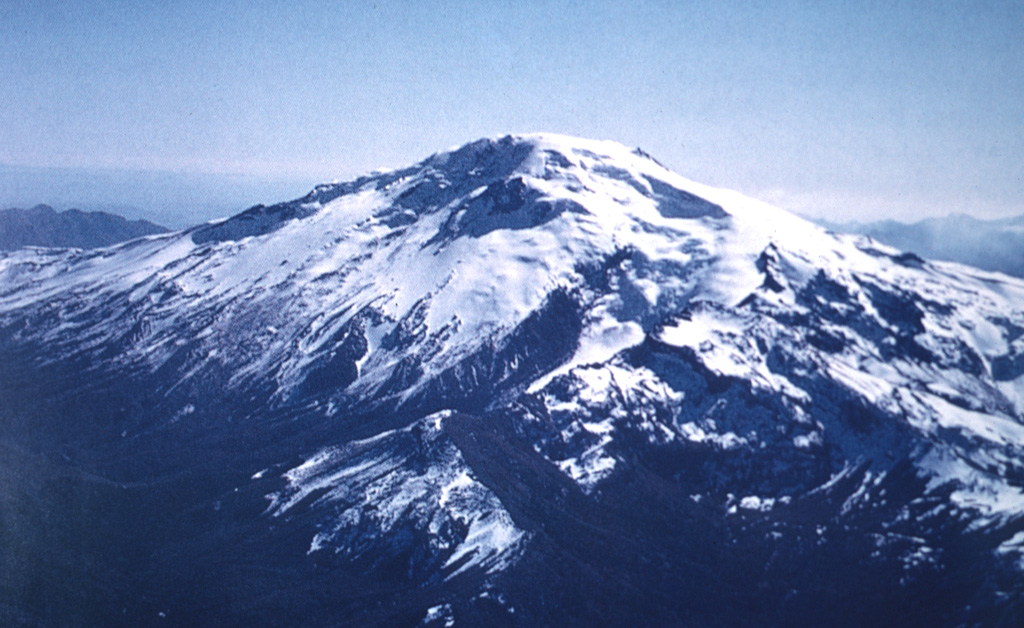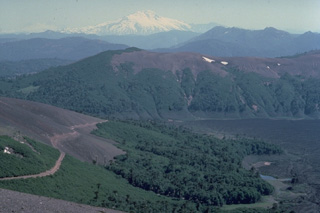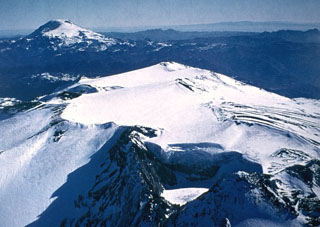

In a special statement issued on 27 January, SERNAGEOMIN reported that a small area of incandescence on the SW part of Callaqui’s summit crater was visible in webcam images overnight beginning at 2155 on 26 January. The glow was persistent and visible during dark hours, and was likely the result of increased temperatures at fumarolic vents. More intense gas emissions from the same area were visible rising 380 m the next day. The report noted that this was the first time incandescence had been recorded since the camera was installed in 2012. The Alert Level remained at Green, the lowest level on a four-color scale.
Source: Servicio Nacional de Geología y Minería (SERNAGEOMIN)
Stable during June-August 1997
A report received in early December noted stable activity during June through August 1997. The same report also described a new seismic system and some initial tremor and seismic data. The Department of Humanitarian Affairs of the United Nations sponsored a project that began in August 1997; this enabled scientists to study Callaqui under the auspices of the Observatorio Volcanológico de Los Andes del Sur (OVDAS) of SERNAGEOMIN and the Oficina Nacional de Emergencia del Ministerio del Interior.
The new seismic system includes a vertical-axis, 1-second-period geophone, a digitizer, and a computer. Upon collection, signals are telemetered and processesed by OVDAS in Temuco.
During August-October the tremor had characteristic frequency ranges from 0.9-1.6 Hz. For August-October the number of daily earthquakes averaged 0.96, 0.26, and 0.53 events/day. Seismic-amplitude averages (RSAM values) during the 3 months remained stable at 2.5.
Information Contacts: Gustavo Fuentealba C., Paola Peña S., and Klaus Bataille, Observatorio Volcanológico de Los Andes del Sur (OVDAS), Manantial 1710-Carmino del Alba, Temuco, Chile.
2022: January
2011: December
2009: January
2008: February
In a special statement issued on 27 January, SERNAGEOMIN reported that a small area of incandescence on the SW part of Callaqui’s summit crater was visible in webcam images overnight beginning at 2155 on 26 January. The glow was persistent and visible during dark hours, and was likely the result of increased temperatures at fumarolic vents. More intense gas emissions from the same area were visible rising 380 m the next day. The report noted that this was the first time incandescence had been recorded since the camera was installed in 2012. The Alert Level remained at Green, the lowest level on a four-color scale.
Source: Servicio Nacional de Geología y Minería (SERNAGEOMIN)
Based on a pilot observation, the Buenos Aires VAAC reported that the top of an ash plume from Callaqui was at 3 km (10,000 ft) a.s.l. on 2 January. Ash was not detected in satellite imagery under clear skies.
Source: Buenos Aires Volcanic Ash Advisory Center (VAAC)
Based on a pilot observation and analysis of satellite imagery, the Buenos Aires VAAC reported that an ash plume from Callaqui drifted NE on 22 January. The VAAC also reported that an ash plume from Nevados de Chillán, a nearby volcano 120 km N, drifted SE on 21 and 22 January.
Source: Buenos Aires Volcanic Ash Advisory Center (VAAC)
According to news articles on 14 February, scientists from the Universidad de Concepción will install instruments to monitor Callaqui. Local residents reported feeling earthquakes and hearing constant rumbling noises during the previous few weeks.
Source: El Mostrador
Reports are organized chronologically and indexed below by Month/Year (Publication Volume:Number), and include a one-line summary. Click on the index link or scroll down to read the reports.
Ash emission from summit
A small phreatic ash emission from its summit was observed in October 1980.
Reference. Moreno, H., 1985, Personal communication.
Information Contacts:
Steam jetting from fumaroles
Steam jets from that rose 300-400 m from fumaroles on the SE flank, 200 m below the summit, were observed during dry weather at about noon on 9 and 16 March.
Information Contacts: J. Naranjo, SERNAGEOMIN, Santiago; H. Moreno, Univ de Chile.
Continuous fumarolic activity at main vent and upper S flank
A late-March overflight made after a prolonged dry season enabled views of Callaqui with relatively low snow levels. At the time of the overflight, the main vent at the summit showed vigorous steam emissions and sulfur deposits were noted around the two main fumarolic vents. Similar levels of fumarolic activity were noted over the preceding three weeks. Both the south side of the summit and the uppermost southern flank, at the head of the glaciers feeding the Río Malla, had continuous fumarolic activity. Rocks in these areas were highly altered. Emissions from the southern flank were more diffuse.
Information Contacts: Jose Antonio Naranjo, Servicio Nacional de Geología e Minería (SERNAGEOMIN), Av. Santa María 0104, Casilla 10465, Santiago, Chile; Hugo Moreno Roa, Observatorío Volcanogía de los Andes del Sur (OVDAS), Manantial 1710-Carmino del Alba, Temuco, Chile; Simon R. Young, British Geological Survey (BGS), Murchison House, West Mains Road, Edinburgh EH9 3LA, United Kingdom.
Stable during June-August 1997
A report received in early December noted stable activity during June through August 1997. The same report also described a new seismic system and some initial tremor and seismic data. The Department of Humanitarian Affairs of the United Nations sponsored a project that began in August 1997; this enabled scientists to study Callaqui under the auspices of the Observatorio Volcanológico de Los Andes del Sur (OVDAS) of SERNAGEOMIN and the Oficina Nacional de Emergencia del Ministerio del Interior.
The new seismic system includes a vertical-axis, 1-second-period geophone, a digitizer, and a computer. Upon collection, signals are telemetered and processesed by OVDAS in Temuco.
During August-October the tremor had characteristic frequency ranges from 0.9-1.6 Hz. For August-October the number of daily earthquakes averaged 0.96, 0.26, and 0.53 events/day. Seismic-amplitude averages (RSAM values) during the 3 months remained stable at 2.5.
Information Contacts: Gustavo Fuentealba C., Paola Peña S., and Klaus Bataille, Observatorio Volcanológico de Los Andes del Sur (OVDAS), Manantial 1710-Carmino del Alba, Temuco, Chile.
This compilation of synonyms and subsidiary features may not be comprehensive. Features are organized into four major categories: Cones, Craters, Domes, and Thermal Features. Synonyms of features appear indented below the primary name. In some cases additional feature type, elevation, or location details are provided.
Synonyms |
||||
| Callaquen | Collaqui | Cordillera Blanca | Niullihuelco | Llagdeguin | Ketrudehuin | Unalavquen | ||||
Craters |
||||
| Feature Name | Feature Type | Elevation | Latitude | Longitude |
| Epun | Crater | |||
| Nireco | Crater | |||
| Pichimalla | Crater | |||
| Quillaicahue | Crater | |||
|
|
||||||||||||||||||||||||||||
There is data available for 2 confirmed Holocene eruptive periods.
[ 2012 Jan 2 - 2012 Jan 2 ] Uncertain Eruption
| Episode 1 | Uncertain | ||||||||||||||||||||
|---|---|---|---|---|---|---|---|---|---|---|---|---|---|---|---|---|---|---|---|---|
| 2012 Jan 2 - 2012 Jan 2 | Evidence from Observations: Reported | |||||||||||||||||||
|
List of 2 Events for Episode 1
| ||||||||||||||||||||
[ 2009 Jan 22 - 2009 Jan 22 ] Uncertain Eruption
| Episode 1 | Eruption | ||||||||||||||||||||
|---|---|---|---|---|---|---|---|---|---|---|---|---|---|---|---|---|---|---|---|---|
| 2009 Jan 22 - 2009 Jan 22 | Evidence from Unknown | |||||||||||||||||||
|
List of 2 Events for Episode 1
| ||||||||||||||||||||
1980 Oct 16 ± 15 days - 1980 Oct 16 ± 15 days Confirmed Eruption VEI: 1
| Episode 1 | Eruption | |||||||||||||||||||||||||
|---|---|---|---|---|---|---|---|---|---|---|---|---|---|---|---|---|---|---|---|---|---|---|---|---|---|
| 1980 Oct 16 ± 15 days - 1980 Oct 16 ± 15 days | Evidence from Observations: Reported | ||||||||||||||||||||||||
|
List of 3 Events for Episode 1
| |||||||||||||||||||||||||
[ 1937 Sep 18 ] Uncertain Eruption
| Episode 1 | Eruption | ||||
|---|---|---|---|---|
| 1937 Sep 18 - Unknown | Evidence from Unknown | |||
[ 1872 ] Discredited Eruption
[ 1864 Oct ] Uncertain Eruption
| Episode 1 | Eruption | ||||||||||||||||||||
|---|---|---|---|---|---|---|---|---|---|---|---|---|---|---|---|---|---|---|---|---|
| 1864 Oct - Unknown | Evidence from Unknown | |||||||||||||||||||
|
List of 2 Events for Episode 1
| ||||||||||||||||||||
1751 Dec 31 Confirmed Eruption VEI: 2
| Episode 1 | Eruption | |||||||||||||||||||||||||
|---|---|---|---|---|---|---|---|---|---|---|---|---|---|---|---|---|---|---|---|---|---|---|---|---|---|
| 1751 Dec 31 - Unknown | Evidence from Observations: Reported | ||||||||||||||||||||||||
|
List of 3 Events for Episode 1
| |||||||||||||||||||||||||
There is no Deformation History data available for Callaqui.
There is no Emissions History data available for Callaqui.
 Snow-capped Callaqui volcano rises in the distance north of the foreground slopes of Lonquimay volcano. The dark area at the right in this January 1989 view is a new lava flow from a NE-flank eruption of Lonquimay that began on December 25, 1988. The lava flow split into two lobes, the Laguna Verde lobe (seen here) and the Río Lolco lobe, which eventually traveled 10 km to the NE. Callaqui volcano in the background is another historically active volcano of the central Chilean Andes.
Snow-capped Callaqui volcano rises in the distance north of the foreground slopes of Lonquimay volcano. The dark area at the right in this January 1989 view is a new lava flow from a NE-flank eruption of Lonquimay that began on December 25, 1988. The lava flow split into two lobes, the Laguna Verde lobe (seen here) and the Río Lolco lobe, which eventually traveled 10 km to the NE. Callaqui volcano in the background is another historically active volcano of the central Chilean Andes. The ice-capped, 3164-m-high Callaqui volcano has an elongated profile due to construction along an 11-km-long, SW-NE-trending fissure. As many as 16 well-preserved volcanic craters, the majority of which are on the SW flank, have erupted along this fissure and produced lava flows that mantle the volcano's flanks. Two large, ice-filled craters are located at the summit, and intense solfataric activity occurs on the southern side.
The ice-capped, 3164-m-high Callaqui volcano has an elongated profile due to construction along an 11-km-long, SW-NE-trending fissure. As many as 16 well-preserved volcanic craters, the majority of which are on the SW flank, have erupted along this fissure and produced lava flows that mantle the volcano's flanks. Two large, ice-filled craters are located at the summit, and intense solfataric activity occurs on the southern side.  The broad glacier-covered summit of Volcán Copahue along the Chile/Argentina border is seen from the SE with conical Callaqui volcano in the distance. The lake-filled active crater of Copahue (lower center) has been the site of historical eruptions. The composite cone was constructed along the Chile/Argentina border within an 8-km-wide caldera formed 0.6 million years ago. The eastern summit crater is part of a 2-km-long, ENE-WSW line of nine craters that cuts across the western rim of the caldera.
The broad glacier-covered summit of Volcán Copahue along the Chile/Argentina border is seen from the SE with conical Callaqui volcano in the distance. The lake-filled active crater of Copahue (lower center) has been the site of historical eruptions. The composite cone was constructed along the Chile/Argentina border within an 8-km-wide caldera formed 0.6 million years ago. The eastern summit crater is part of a 2-km-long, ENE-WSW line of nine craters that cuts across the western rim of the caldera.Maps are not currently available due to technical issues.
The maps shown below have been scanned from the GVP map archives and include the volcano on this page. Clicking on the small images will load the full 300 dpi map. Very small-scale maps (such as world maps) are not included.
There are no samples for Callaqui in the Smithsonian's NMNH Department of Mineral Sciences Rock and Ore collection.
| Copernicus Browser | The Copernicus Browser replaced the Sentinel Hub Playground browser in 2023, to provide access to Earth observation archives from the Copernicus Data Space Ecosystem, the main distribution platform for data from the EU Copernicus missions. |
| MIROVA | Middle InfraRed Observation of Volcanic Activity (MIROVA) is a near real time volcanic hot-spot detection system based on the analysis of MODIS (Moderate Resolution Imaging Spectroradiometer) data. In particular, MIROVA uses the Middle InfraRed Radiation (MIR), measured over target volcanoes, in order to detect, locate and measure the heat radiation sourced from volcanic activity. |
| MODVOLC Thermal Alerts | Using infrared satellite Moderate Resolution Imaging Spectroradiometer (MODIS) data, scientists at the Hawai'i Institute of Geophysics and Planetology, University of Hawai'i, developed an automated system called MODVOLC to map thermal hot-spots in near real time. For each MODIS image, the algorithm automatically scans each 1 km pixel within it to check for high-temperature hot-spots. When one is found the date, time, location, and intensity are recorded. MODIS looks at every square km of the Earth every 48 hours, once during the day and once during the night, and the presence of two MODIS sensors in space allows at least four hot-spot observations every two days. Each day updated global maps are compiled to display the locations of all hot spots detected in the previous 24 hours. There is a drop-down list with volcano names which allow users to 'zoom-in' and examine the distribution of hot-spots at a variety of spatial scales. |
|
WOVOdat
Single Volcano View Temporal Evolution of Unrest Side by Side Volcanoes |
WOVOdat is a database of volcanic unrest; instrumentally and visually recorded changes in seismicity, ground deformation, gas emission, and other parameters from their normal baselines. It is sponsored by the World Organization of Volcano Observatories (WOVO) and presently hosted at the Earth Observatory of Singapore.
GVMID Data on Volcano Monitoring Infrastructure The Global Volcano Monitoring Infrastructure Database GVMID, is aimed at documenting and improving capabilities of volcano monitoring from the ground and space. GVMID should provide a snapshot and baseline view of the techniques and instrumentation that are in place at various volcanoes, which can be use by volcano observatories as reference to setup new monitoring system or improving networks at a specific volcano. These data will allow identification of what monitoring gaps exist, which can be then targeted by remote sensing infrastructure and future instrument deployments. |
| Volcanic Hazard Maps | The IAVCEI Commission on Volcanic Hazards and Risk has a Volcanic Hazard Maps database designed to serve as a resource for hazard mappers (or other interested parties) to explore how common issues in hazard map development have been addressed at different volcanoes, in different countries, for different hazards, and for different intended audiences. In addition to the comprehensive, searchable Volcanic Hazard Maps Database, this website contains information about diversity of volcanic hazard maps, illustrated using examples from the database. This site is for educational purposes related to volcanic hazard maps. Hazard maps found on this website should not be used for emergency purposes. For the most recent, official hazard map for a particular volcano, please seek out the proper institutional authorities on the matter. |
| IRIS seismic stations/networks | Incorporated Research Institutions for Seismology (IRIS) Data Services map showing the location of seismic stations from all available networks (permanent or temporary) within a radius of 0.18° (about 20 km at mid-latitudes) from the given location of Callaqui. Users can customize a variety of filters and options in the left panel. Note that if there are no stations are known the map will default to show the entire world with a "No data matched request" error notice. |
| UNAVCO GPS/GNSS stations | Geodetic Data Services map from UNAVCO showing the location of GPS/GNSS stations from all available networks (permanent or temporary) within a radius of 20 km from the given location of Callaqui. Users can customize the data search based on station or network names, location, and time window. Requires Adobe Flash Player. |
| DECADE Data | The DECADE portal, still in the developmental stage, serves as an example of the proposed interoperability between The Smithsonian Institution's Global Volcanism Program, the Mapping Gas Emissions (MaGa) Database, and the EarthChem Geochemical Portal. The Deep Earth Carbon Degassing (DECADE) initiative seeks to use new and established technologies to determine accurate global fluxes of volcanic CO2 to the atmosphere, but installing CO2 monitoring networks on 20 of the world's 150 most actively degassing volcanoes. The group uses related laboratory-based studies (direct gas sampling and analysis, melt inclusions) to provide new data for direct degassing of deep earth carbon to the atmosphere. |
| Large Eruptions of Callaqui | Information about large Quaternary eruptions (VEI >= 4) is cataloged in the Large Magnitude Explosive Volcanic Eruptions (LaMEVE) database of the Volcano Global Risk Identification and Analysis Project (VOGRIPA). |
| EarthChem | EarthChem develops and maintains databases, software, and services that support the preservation, discovery, access and analysis of geochemical data, and facilitate their integration with the broad array of other available earth science parameters. EarthChem is operated by a joint team of disciplinary scientists, data scientists, data managers and information technology developers who are part of the NSF-funded data facility Integrated Earth Data Applications (IEDA). IEDA is a collaborative effort of EarthChem and the Marine Geoscience Data System (MGDS). |